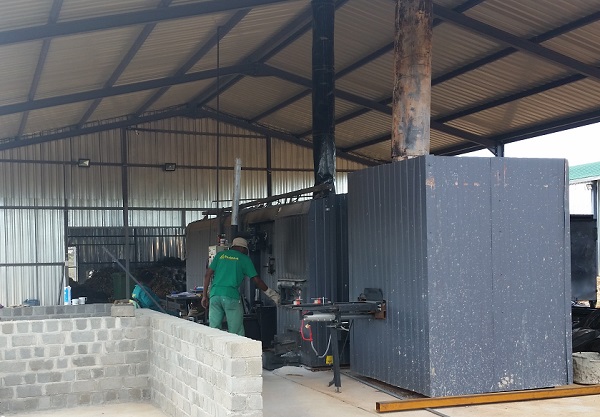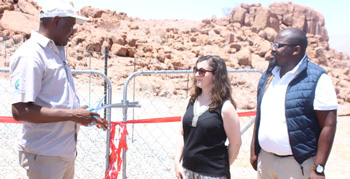
New kiln makes “green” charcoal using Cheetah Fund’s Bushblocks

The Cheetah Conservation Fund has taken biomass processing a step further with the commissioning of its new CK-3 carbonizing kiln to turn invader bush into briquettes. The new kiln was demonstrated recently to charcoal manufacturers and to representatives of the European Union.
The kiln’s acquisition was funded by the EU under its Climate Change Adaptation and Climate Change Mitigation Programmes.
The Cheetah Conservation Fund pioneered the use of wood to manufacture its proprietary Bushblock, a wood-based fuel pressed into logs by using wood chips and resin. The new CK-3 kiln builds on this technology by carbonizing the Bushblocks in a process similar to conventional charcoal production but with far less environmental pollution.
“The CK-3 kiln is a ‘green’ charcoal technology”, said Bruce Brewer, the Cheetah Fund’s General Manager. “The CK-3 carbonizes our Bushblok briquettes, which densifies their caloric content and reduces shipping weight, making biomass-derived wood products like Bushblok more likely to capture a greater market share.”
The CK-3 carbonizing kiln offers a technology that improves upon the process for converting sustainably harvested thornbush into fuel briquettes
Towards the end of March, the fund demonstrated for the first time the use of the kiln to representatives of the Namibian biomass industry and other stakeholders. The kiln is installed at its Biomass Technology Demonstration Centre at the fund’s Field Research and Education Centre in Otjiwarongo. The kiln was installed in November 2016.
Untreated wood is stacked inside the kiln which is then brought to operating temperature. Two interconnected retort chambers make use of the off-gas generated by pyrolysis reactions. Depending upon raw biomass type and moisture, the CK-3 may be able to produce as much as one ton of the lighter-weight, carbonized Bushblok briquettes in a single 24-hour cycle.
“We believe biomass represents a major economic opportunity for this country. Bringing biomass technologies like this to Namibia will have the combined benefits of creating much needed employment, generating electricity, restoring wildlife habitat and improving farmland productivity”, said Brewer.
Initial biomass fuel technologies are utilised in the manufacture of briquette logs, charcoal hex logs, lump charcoal, and for pyrolysis-based electrical generation. Phase two will include other promising technologies to be employed in wood pellet production, including alternative chipping power trains and Stirling engines. The CK-3 is primarily used to carbonize some of the Bushblok produced by the Cheetah Fund. It also produces charcoal from raw wood.
“The Cheetah Conservation Fund’s Bush Project and its sustainable harvest of overgrown thornbush restores grassland for farmers and livestock allowing more space for predators and their prey. It also helps stave off desertification, which is a critical concern for Namibia with its arid climate and millions of hectares of encroached lands”, said Dr Laurie Marker, the fund’s Founder and Executive Director. “We are very pleased to have the support of the European Union in this important project”.












































